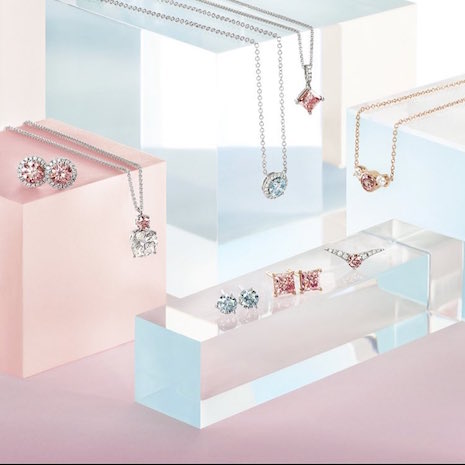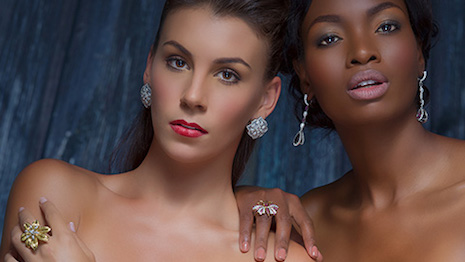The global diamond industry experienced a strong 2017, with 2 percent growth across all industry sectors propelled by a dramatic increase in production.
According to Bain & Company’s eighth annual global diamond report, the diamond market is expected to see further growth for the foreseeable future. Nonetheless, companies need to reevaluate how they reach millennial and Generation Z consumers as their purchasing power grows.
"The diamond industry closely mirrors the luxury industry in its resilience to socio-economic turmoil around the world," said Olya Linde, partner and lead author at Bain & Company, Moscow. "In 2017, we saw notable growth across all segments of the diamond industry value chain even in the face of increased market turbulence, continuing a climb that started in 2016.
"This is a trend we expect will continue through 2030, despite several challenges that will reshape the way the industry markets itself amid changing consumer preferences and the increasing influence of lab-grown diamonds," she said.
Diamond demand
A strengthened United States economy – including higher wages and lower unemployment – is behind a 2 percent increase in retail diamond sales.
Demand in China grew for the first time since 2013, primarily due to millennial buyers. Revenues remained stagnant in India while diamond sales declined in Europe and Japan.
After eight years of flat production, all the top mining companies increased production with volume reaching 151 million carats. However, the increase was a result of some lower-quality stones, which had a minimal effect on revenue.

Diamond growth is up in China but has declined in Japan. Image credit: DPA
Although it remains to be seen what impact holiday sales will have on this year’s performance, Bain reports that the diamond industry saw a strong first half of 2018. Higher rates of tourism and appreciation of the euro should turn around the diamond markets in Japan and Europe as well.
Bain believes the diamond market can expect a positive outlook through 2030, with most demand coming from the U.S. and China.
Interest in mined rough diamonds is expected to grow 2 percent annually in the next 12 years. During the same timeframe, rough diamond supply is projected to be negative 1 percent to 1 percent annually.
There will also be growing competition between natural diamonds and lab-grown diamonds.

De Beers' lab-grown diamonds set in earrings and pendants. Image credit: De Beers' Lightbox
With the launch of Lightbox Jewelry, De Beers recently made its first entry into the lab-grown diamond market.
The new brand focuses on creating sustainable diamonds at a more affordable price than their mined counterparts. The brand’s products begin at around $800 per carat and $200 per quarter carat, significantly less than De Beers' mined diamonds (see more).
Per Bain, if diamond companies continue to successfully differentiate between the different type of stones, the effect on natural diamond demand will be limited to 5 to 10 percent in value terms by 2030.
Lab-grown luster
The evolving preferences of younger, digitally-savvy consumers and growing presence of lab-grown diamonds will have a great impact on the future of the diamond industry.
According to De Beers' Insight Report 2018, millennials and Gen Z consumers share characteristics such as placing importance on the meaningfulness of love, digital native qualities, authenticity, individuality and self-expression, as well as being engaged in social issues.
Last year’s sales showed that self-purchasing in the United States is growing, now accounting for one-third of diamond pieces sold and more than 28 percent of value. Most diamonds sold are for special occasions, making up 63 percent of all purchases, and only one-third are intended for daily wear (see story).
De Beers Group’s Forevermark is responding to these changing attitudes by empowering women through a campaign championing their ambitions and daily victories.
The #BetterHalfWithinMe campaign was created with Indian women in mind and spotlights half-carat diamonds that women buy for themselves, as opposed to jewelry that was received as a gift. Instead of portraying diamonds as a symbol of romance, the jewelry is presented as motivation or reward for pursuing personal goals (see story).
In addition, the lab-grown diamond industry is poised to explode in popularity in the near future, thanks to high interest from young consumers and millennials who are willing to spend big on created diamonds.
The idea that lab-grown diamonds can act as a more sustainable and viable alternative to mined diamonds is increasingly prevalent among younger consumers, who are far more open to the idea than older generations.
MVI found that 74 percent of young people surveyed agreed lab-grown diamonds are better because one can get a larger diamond for the same price. Seventy-six percent also said they would buy lab-grown diamonds to save money (see story).
"Millennials and Generation Z are still buying diamonds, but the way they go about shopping for anything, including diamonds, is different than their predecessors," Ms. Linde said. "Continued future demand for diamonds will depend largely on the industry’s ability to market its jewelry successfully – specifically the process of buying and owning a diamond – versus other types of luxury goods and experiences as well as the growing influence of lab-grown diamonds."
{"ct":"uK0h4+amN6qpOKJteYZ6JZBWKWJC+vM6U\/V5qrPRbPdilB2hXNNlULpudsgzA8WZ4piZ0QWzAtRujhO7NYh+N1B7fmAotYq2oCvSlT6l8gwX0TdxRWWdjQpqINOL8tJNycrgUlOlGfLYtpZYU2sEbYWYW6u2EOYX4QSc8a+tjH1oF0a5kO+Ahv\/t0vchkPmMRF6+aBvxp8g\/RlZxFUFrDsGqGxhxCajLeSZzPUSAbYoIpTx4u661ZQ4kpGpH183VRC4ZMJSDN48vbvCTaAIvCvpomMdNtl19VTzenBc+oYaYgl\/KGJdezH6rbUrGDV4KzHgynTLOhjjXSkJ6MHeq0dxhwUcslH\/q2BzmS7eyADAbYm6PwtyCwuBidb29zFNOkX9oOtqd64Vl1SpXoL7AEyvgmfxqpUDMcxjyVSR8aVmBQ+5BbfojMOipQ0Bir8U6oDnPvTTHv6ugm\/q0GORD37ycNtP+9RPP+1ogA4SjyuMw1860qbV3L8fJ1HWhPkc9kciIwOvEukiVRbogcQ5qZR8wrNprYvyXYQGgAufEjdkBzg0fOu1eXr7pYxg3mpyk59ewMYHNGUhsowi8Axo2pGlUkRTTNnzd2ZMh6MT5qgNK+edkte18pMu1wAVgWzkbO1TxqnXCX8UxIX1pa11iujQAiWN9Dye99e86Y5XDRDoN6ciLj++FWcpVzFNHVP7aQmH+XFgZv3XO3u\/J7Df0FzVM2xaTXfQFtIDvSCGIJq7hMKzwaDglDiJfwQMvGamVdymdl8dqpEu\/SlcFKsli8LSBwVE+ewkjkXg1IjpzyO0C+oGu9aaOcvp8p8b3jdPSN3+\/bZsl417eURcFB0FY1cUtfqPJaTCNNQ9Qu+1Rzl7L8wUvt88hCAv4EuNkH4keBPawKgEZHQhe2q\/O6ffJUJW67F3wbyTX9RGAb\/UD2SgDi2aUjxF5xgDwVDjvAWGWQcdKCJAS3KsAlSLsaloUfT8xZhWNIEAm5ljnGV23C5XOwPa86r6c+K4CXcDCesCWn+f\/zR1TSt6wmvEuTv1eEy9MZp82yuCmWTMGrGMMmvvI2XoKrAtLU2tE7yStDloROUhOqFzVOm\/pQ48pmidBAiqxyAkcT+QRWGUE0uortYBhNl91jBmsIOd5Xjng7pQdcFJ\/y8SGvYMCn+WOQwkGfAgPSHH25Wu6Oq05a9IzocEgDHisnZFHp5eV+ANA9z9kuhuKa0EGmCQN2DQuncK+8bgjCNm+u5qt\/JE8fedjFU29lhzLkgJ\/v6GTwyf1gVpJ1yP\/xNZsptGrjX65AqE7fCWu1x2XO37XfK+BF5GDZe2MHQsSok3oHSLVqqcOYERU67d8V99uPM054woGkRfQ1ygksDIPO\/1lvmcLpvO+IgmBlK15L6ekB5Qk60mG73k49Uqagfu+7mrsSB32xN\/YcktdkRPAXjiuvUnsZA9cRC\/UDPn0kP\/ZkrYhoLRVBbqaJxPHBQKAA9mSUVRebsu3Fngw3OOLFF+8SENgxfrydlNkypoXUqYuTa1xF52TGdm3ZR4o\/CyYRndMrtGe3aMGjY6v+OjvbAR0ZQwQBg0mMfE2T8+Pl3w4Anl2zDZ5Lv+WNzOHzIfXLXvE3opyrM0UWu9C3NVE3q8nmO5XkKwpIy+RrK1\/t42OKy5b2XGOKQF7JDWkIBVoXzexcnz184BWG\/p9S\/3vS\/zUmdIImfS2pfQAmyc1Hvwz6lygJSpXqxVj3\/K3EHXt0EaWTyXV5HxmmpUqMv+vb+Kdtk7TCYRMTQz3RAXj6hIi+2ova31UXS\/fY0SnFzsd+kcgP+QeW2MBrfMjdBFUw\/XD\/WiaP7CBqZift4MDSOfLjzJ8j8WuiAvsRYaq3X0h6ZmwH9nWCb0ZHhuZJpDb+yl97l56S\/ymZoLyrAhGjv+gaxmViAchFRpeH3\/rGE1OJAfs5E2T75fRAGXg+jucmg7JVefR+zvmauZyHgs3naovj7NkjMr5P2MqxbvWupPlj7hrff53+Z5nN+dc9OpCZnkF517fxEvnSHknWTjBWoCPC9ss8yhLBVwvxZKbHNLh0GwiGB7\/prtRrfSQr8HzOi5jGMbHXQYrGFmWvskMAlYJGWIxIuecxJi6NTGF2VexdEqT7cJdR6GShEgwSK+KSd+7ydN6tafBNusu2XVMjK5K7wBtQTA2ZliSgFHU8IeSGA0vvSwnUIQbJG2yTR1b8dXiRu8s6rX1VVz\/3BKixLTgy4zV8IkfoMrztxZjHFvtIkYN\/xna3d8DPCfvQHOmEc2M4CqzMoeUWJ3bqUGbRxRruxMg+3lst9VL9meAW91vUZBvxa8sXJEsaXqh\/5GnYwyEyOf1zfB24tXfbjHCAo6dqFpurdElhYcLZc4y0VXIhCAaPDaR41KDJFiHvuBNJ2SLisz6+cRYpiFVLoGcLKwbalj13bJytStFsGMdP9WOEkkpiPnuaY2\/GjLdJx9qGc65MFi06WUvzq7VJ3OKq\/IdyQcgjows9k+L0QR4cxrzLkP\/vIUoLeqT\/lbQ7X1MtBoZywQZwJU9rrqKwUMT\/D4OjdWXLAuiSg18sRDAWqrcw2OLGED52ewsBKf0FELeEczOwCDkSYMVj\/7UKeC6T9vZtx2rhvHL48Fyvw2phHWil4FnELHmGSP4U8S62Bl5WWLQileUhTPWvroxgrsXYxRFTZnxxMyTevFxrWKODedM6xaOp2o8Ge3WBpxJ074ZSl1+IQr\/8pZA3iMc0qmoY3Z0DKkL5TyHwzcoVJKvHjK9bRAc5pETyLw\/i74sZpQXkgQlZvxPfw\/HvfHu51QcSMq22\/LUsSUMOqSTJIDkPfplOg5TBm4NYJMq32CzxT86IJAp2IWbHIhDQ34PNa0iqzIMH3yZBLcE6Iznzr\/J\/sbCEuVjmaqdpo\/0ioT+non6M4DhKzjJmjnpH6B04YHWT8eN1k0kmwRYksgBYpsmtcpvz2+ln5Ty3a++ooQxoOrxkOL2USK3o739vi7VPh68puvCuQHaLfUo0mKsXyGeiZa5yYfLeQHxlTFlSc7z2rJDSTbEgnCFvd8quemd5nfWzt6Zs+OEec2CovVRJGc0lAXNV6+t2nyl\/qk9iMjJSXolcTdWKWVisNrhWEe0VycBNa5XO612xWzKNh\/gsfDPYso9eIL4+IqVY6V6WYth5Tu+xdGjEp1CcSmz3JqI5C0NJMe+Efg4aSWW3ZIRitIQUt\/Sar5glMUBG1J3GOH\/ZF6rza0WuzTu6KzT\/oYwW65U6HDHMoFAFFpYLGe0TqDp3zmbNk3eirvbAEOgDNteTreXDZXJXZo\/zm4bDVMJgT4IuS6DQqEqS5qkHPBckdRMMwCjgB+B056+VsffWvDHLkqf5wBcSXPJ+iHgp6fEB6v2SIWpCDjdttNLtm2dI06AKBkcpc0psmCLvjOYZe5E1uIzbi443NCXQ0jt0qzGN2nn4t2M55T5pTMCRqZ9vU6suzV\/6UAPR1nb7NmzLjPc6pW2hHJJQqmEUq4l4l+rMWQSNST9kMP29+O8\/5ntfg2wQzzVmFL9ECj1xJeI7my2YPmNZThrrlromqW7uyupUTwO0QBF4xDBkjMx4UkjlIW3kHDitF3FONlPMDcMp6I7wYet5XiVSLYEPxs9kHrqlenk\/jLFTPAggtwjWuE5dkPDm7aeXeGTC8B2zVronOCZ\/HsTKYChFWFPi2OQHX3b+vzZeqVgByuWXTa4W\/PZgr8ghHhUzM8+7h6apkXZAjezqh23EoOmLYEHlVEI9mwnINgTIvYZNQllgNm\/k3iy2\/H0Xb+8rghFbtNpg+0rWRSIXSs9AcCKf14jZUHm8MYaoGOKTtMU4mDeITHZiQxUdN2N6Ijzk6vTeWagC9RM\/GEq2Rp3LLL4jWqLJFJDWmLq+GwE2gtx2jwdmqDZnbLGOhSu7JXfvdujonOsHsn9hn5uP1bmTTEdY5tGLGHzhem9D9b0gQh72quj\/FIrHPOLq0aj0R2L2xk\/tuYQY6+qo9AC0ESt93KEY5nratrz9ISchh4525s3z4+1s3PA0UnD\/0cI3vdhee1R1pgdDrPikxnACH6hBlKx0R57E2rVfeWxtL2Yv62JHG+mrw0hLlodJVLDOLDBHYtfmVuyOG\/rLKMQyrUf9h+vMNdxyIOMOewKS8onjET1qxdUq6a7v4OAyKp8vDfJp0lyu3UkHbPTVcUMhhX6paVfhr25G0qdrAxRklY08vL0mF7cjqnWfXNQJqTo\/kt+DfPBSLiSeEvw23WrNDklnaNR5+rJ4Iku0Q3WJwkheYZYFnw5uttls0TgxpfOUGRCwOnNslxaF6a+MbYvrXPqq6zUFHOuTqK3tf2Wn5YS\/eCBSGR2yzgDz7fZTQFGvmkwDo0y4wrO4bTGrubiCMVzOQvz2ZRNf1JicqDGWnZlMiTect4AWy+nMSv4x2a9GY9IrwACe3RgKAOa9K3dEEwqJiK24cF6NO+\/F\/Q31hSgHizJZb6sHzJjg8sDmFiQw6ZifwAwIvKCPrzrnniOmqtUbT1BN81+U9ASTHjIwVUWpAkxpj9WuvbsiJDgzsjO3wiT\/oBfbdvokplsZixIcTFKDmtazBW3lwaQVq29YSxF3C\/lhcaaCq6e4l2aVWnb3Lv3pWf50CoXLZ80cHc50X++GJbdNhDAjWYFw3Z9XcSms6XfxQeI2Ip0gSsF165QXNGhsO3bpqYsBwzUPo8kHPuEWYRZEMXKdJXl\/er83kphSjeb1sTFSX8R0pt6wL4MbyqT\/aWDAZGlvPrHAE5tQULrXvEjeFzKGlAANUYCy9xPL2rrdl2Ikon0YYRGrlgN2A5DzwTY+DRxP8pMn\/JGJxxDppdKRHsoDyboKflNDJuFp8AGVN\/RY0c4+CvmyqERFyCZBoT\/6dH1\/ml8Z9JDbIf0ldta14G+RlgRWfar5Jp3v0WRejKYSFkuR5dgEgSP1IM5VtnD\/eSVfQum+nD8+TB9RlOL82q0tCvWT65VD8Pg8wXq1aB+i5ALCMfB9Oyzpz1KJ7LdcHkq1ko+rUWCwULmkAoVlqm9UDYssTzaTS\/UjAFukoyGFQoWdc6A\/znXVXSCxZGyPOoUvgTeqBa7\/HqwSLXGEbIlL9\/QkutmzbwwXRgzd5dcfay4jtsyR8zawsT5t\/Pdi1ECQnmwNdfHDyEVoTmX9w4icV9zEyvPP78PupfhzL3owThVvgL9gQzsyxzTfRF8or9sZ+CF+lyNTNSsYXrbUVGbw89BfGsegaMqWlAR8UeJQZ\/ZI9gv0+Y5BzqmtYcv3neZZQ7zl8+YO\/esIX4hrBDK+upSmfAa2xSfvI8nhPhoKyfy1Ory6stc\/4R0o1chuS+gLjDcsscXhPpF\/dOYbykogkaP3TrW0Wabtrg+BF+L5Uz0jUV\/4TAvavO9A\/fmP8FQZO22YoeMvr\/iGR0FGn6DnHzlhqT17Lm027c\/y7XFTYxSWzWmSOuGgQu6c4yzLw\/pFbpstCKhoQTkOfoVorkS7Btui2jmtdOD2B+VvcFg6nQdGnau5B8RzRMLbNIpjbsHIUFW2Py8K2pukHwwZ4VdAmDdZhdV3naAM5FYfmv1tl2Ut5CgvYfIEQhSEKz\/VzVTgqxMtlNH0hIn6rANW7p93KWUWYuBZbMcelEwd2jZKdkjONCEeSCHTRorqRDT6iuAOUW+WkuRg7vTs06VdQxZZUCpjYk2XgUMTVSmc1JqA6\/v17DkZVjNXNitVFgnb+IJx79TeUC1yhzP\/TDo59V7J14Nn5ithBt\/Ad77NjVuZU\/wSrxK52hHYoBhWJ+ohAIegZ1ATWoXCbVxNEfRxyLfKYBo0YQ1v6pvQJs1gAYeisgIMTIomCpXGyhwjFRgQEL925dGOdVDBmvEojcZmUgqAMptJa5jprSUBJnDy+419fVxB6dwuOxd0ssY\/MAXbfneH6lcfuKG88dY42N6LHJlzVVigOwI9NxDPE2sLi+X2uTA9hZ0EyHFgDsQXxDtf3ReUCYBHKAaHWHRxiDdPpBAUpJvIBk8glZVI01GiZ8Vipzg7Yrx\/obUuzLJbPQDqhyKOLmnwlltcjPOEocEcyz4\/o590+kzHBd5NbXzFiOu7GCrVNsGwHrrWSQ6ulHyK\/tHbFiz3kFDMPwLH1VX+4\/g9PqfpxzyQB1NoYym8MtxZCHjfLdf9wHUxBX9tm2IboiU4xaWAQwzqDedKza5nwrt\/k9ddJx1fbw0GgpYZ6TvahQl79NPXQXf+r9Ai8tbkHntEqX+h5wJg5Gc0km7ToRti7SggiknJeUMnph892imGPD3eoW23Pxh2Sh5AA1IcICK67+MOJsARJa+jW4O\/NAxQScltnNR6yPmcdkh4ZyGdunKUs39KFnYKMu\/yGzmXcgqZHyCjL5xzTuZnMN0xiITZN0N2PtWdz\/14m\/bAOLxJSmlTfNDvt+jZhsGVVBPQWH7sFkj1nUnPwE3M99el00KO7Exb2BPVi0aRyXtXOJtIV\/g7GULPjpCPwSTXNdkMhULAcIWyZyXbbGmKCLSjIDEFg6a++tlvA5x6WmgR3fHJMEm76h7sfD8WlfZ6IP\/9+ljC0ExDYlqz65rM6H4\/A6N8WgQH1jZE5xOBBGxzGUYyxAf7f4XSl+fb9LWegLVMwZO4LghCWdQH3HQgra\/U4iz165VFFgs4nWKrb8+NmIZI\/s554NQkWSu61UqYXKxQcIFQWZ+6OheV3g67hJGOtNGWvRJMh3BnNJItuFqyr5Hv0HVKs+1fYKYbqu0pS3CHijybF8hqtoaw2m+HXzvvyBaXcYcHUJ3JPtnWw5rVy3Nhz7OBhAkOCzBBtgXENrpPZtr4Y\/ex3I+keGPAx7Y+mtut7XMs8AEkv5JwHSUsx6I6jn13VgIYEqj3gTtVH1mLs\/NESUDpq5OMC8\/tJkO14tjqZk3V3tLpWgK8EzgOs0uAHzSZsdLX30E+Sr+KgJ6bZkMliTUoUBXcQi1B3ts80IUnTFnltP9CBg8TwoWFoGc1XZNEyNyNNG2zKMlZoWujVARXxWZ72Cccd\/8SyZed0QqNu51TCDW\/EW3+vIo4Z\/48HZfbibDXCS29kCv\/dTQY15APQuN5CUs2jlpS5BR1viRLTMr7eyFXHrO5HJohXw48mqf\/xKL74lz\/J3U8rY85EW7s6TvKKFrJ8ofGDTGEkT11m5z7LEFXhBDGJyQplMOS37nULFf82fPi1iCaqgYYQvSMOfACQephcBi2Dr9r8qfKRxugregm2VA3N+8PfKmwHZ40DTqj6jgO7Sb3HxRU+1d0wYempyYS7b80vm\/L54NK0nKmrRzXcdnhXSQc+IiNT6MH9+1mCcBYJ0\/2jWZLg1l\/sCNBuKSs9VxoJX0WACT2ZV8ADpE5SQ8oLSw4it5Js7yZLfYIAaXNKQHrpt0OYAnRJykpPgXyt\/CzS5v8AEQkJxTbGskIhWm2aCCo7ASfit0sHhOjBZ9lXMbnskg8gcbb7rATYHextq2KyRKI\/Wj9vEmg3Uk8hp\/zjpS5MAboT4sOEsqDwGBRbSU3JpuoL9No7ZiWBL7NfaxTJPTya6c+TqPLVWghT68UrzvrWEOl9m8I6OdqA88vW0T+88Bx9GH6WVsiIgj4x63w6JWmmDNULKNGdWEQO6IcT8NQI4FaLwPNWqRzvaOKxVjAjgscKseiGLpSiMRiH5hfcGliB3kCRfilM2HkfGH6g06GCUE1WueuJpmOTu+Ac40nshDHh0gvvHxa43l0+5yMnQkzpM9rjk3v+m\/zmqs90zFI+6GbeaCZeHZnG7mzoO4RqNwL7BR05Ca1b+j3ALR3aL\/CIaSqc2Z+\/Vsgu8xFV6lhUbwY\/QWbzeQUzkL7PPEfz8E9cTUaE11xE+EwC2djhtYgJuktIlhNRU5WW5rQH0s4Jk8oFYyUJZ1NMagMkWss5eySHgUPv9dPm3y59FEzI9jjWQTUHwaVhSooorkUn2NdaiDpwnTbZyovKX8+kYHEM3+BFK\/UVbmTmrsZur8mwAEdej\/e+1HHJLX390gb0Aw+\/wWOwUh9R1lfMicbO3zCLlqmeb9EylmU6b32H6P3J9VUtHTkfLbo+1LcpUM1nc1erkR+T5PTFXd66nMXH6JrdLwjDryTGAXTjEqSH149WSImVgJE53lKBsTjbjRrBczeQEEqWlmlluW0SRx\/ms89QX+qVU6ud19JqgyqdhRATZyeYNvthpF8bne2MqfiCVkt6H3cjVSeV3Xf7HUxUFD7mBnMgqRh9rzM18LvaQNUMJhlUqoS+VFcnLmKVK\/8CF59hqpc5ePuq8zplcF+sL5DQ+CzkuWGv2PBZxyViBRSZhNHFIE+Xh93PiuwQ3RY6GnzqxSLkdIeizLgiDF+riNSo1oE3iPSzN9cdWpWpGkXCp3s9LKjMSmpIg0oEeIzjCzJmlwMGpMZBGZulels07ncgEaHEE0\/PLVBZoOz1BtHKPwptkOLwLJU0Aoz6Y8PhxPMtQdihJURy9fbscAOgmGD3F0VuOU3bkWdFHc2jHtdKptixMGxG8qaEIxO085gSWg1K6K3httbGtzfYicTGlPjEoEu\/igA2geRjiKnx10bLbasuMkif1wmr86wIsA+q11hrUN92wHTEl5\/OyZjcL5P1lF6CMKyNO0fC+JJMDpQWbgtjbOVJcBVNxuKLQqB85JpMfpxxOy3jh9AlBiVRu04Td+qe1jjvPHBZP6hUb2YK\/\/D69NRbJKwcDKi0r+fnlNJ2nzZPg1hkAeO8idpprOn2BS\/E5\/UEEYVKGH6xjn9dHcSKp9x2xasBhcYby2uLoTZ\/pdlNhatVnm4PbnQA5aV4LW7ouqEI3zA9Sb97gegTx8JenIw5VH30nGqoR0mm8rKlwxMmc+SpHPpsI0LOmQG30BU1rr85xamnk75xA81jNgr6rAKHBEVJ28lYzSNw2Mq4FB4LYMR9b6RCtXsvCQXNLUeHhl3pu2SWuWAK6fQj8nWqsGAefxvPtdSlPs6V50Gx1qiHa\/ls7wR1oqWxce\/3XEQd717ztTTr8wvuNPnOMjVXVzA87kRr9cZMPKUbpZflrDYDeYFcvSchI83QYt1U+n53ND+Wc5UYkoMaxGaOp57hFZRFprK9Szci62q8n8BFOhraK2\/+iL0aGsBC7AHV\/HoEQkwgQnSDtboee0rVZMtOYrenhZmb782OPKbTGB09yL2kzf2\/w+Emqrl4SeymwcXAiaNL1xy1uMJwWVM89JX4u14vkcUj1hW3WA5qgiZ+eRP44f5UOkz93JzdtnB80qwCGBlTV28O\/1ioG2I1V9iElFhXnmz5GA8s3eXDbAl0PqBoDu1jYy0XTmrbWwj0KZH0F7K3XxERvvWk2Bcocf62bwuzleCMiuGYSKaUb1CpP4Z3GoHkKh0hpoUhjIhNU2LT\/51EBanzHDq2dxver+4Tk0AHO5zjXwrSbrkEu1+xPGbpNCJR4sbRjWeAF+z16l\/jTRUDC+IRdvu7FXl+sR2Wktl4fKSMAihVj8toHwS9qBfhg9FNYzpuSxQx0H6ifvF59il7qWft0MJMIJ+KD5WzzwfwpFi3tFurtpgcJjDv6oDZY3xgf5U1YWQoHVQMRQrlTdJL5NPR4HzH6zoY4rzN++uN+lhXaln1xiqCtGLI63jlFRb9BS3DID1x7mCr4lOr3L4u2N3Fsa0IPRc9d11Rn6izdCe+LxsKv5jxsgkUadGKgS2THeAJAWEagHJgVerWpSZDYGXOjwivTeIF4EPUJUTU8YZH\/CCsca+Bp\/pvH2N\/yJfH1QcwmVOt0DCkNiUN0GBxoT+WxPMXhDULXURTjR\/4SbsczJXdwYlK\/vqHoVbBBSUWPaVeq9\/RsqqsM6YoGMyT8mQHxgKSMmOExN+\/ICMatcRqfzW5JJJCxJ6IbT+628\/KHbwikJupFGGlGO84N1buuyGZe8fzTq\/N6vD6y3dymtcKagroV9zi8srQDrDn3bRK\/rOe1\/6QwLPFYVBU+4AXhpYYt5HXeJNGTec\/bqEV33OQwQ2ipqgvl+pryEa54FjVLv4Fb\/DAhyKv0ed0JT7YYX9E3VfxEyDVJsmP0FL5JOIO3VndzrYy9ogv8d9\/rYNc\/PgiL7zYP5Z1Ggi\/xyhU+Ce8jKYZfgVpGpAOLMZnYW9cWWdyiryTMtJ+aF9L9xVz+dkvnCOKNGGpuPNIspZlmxWw==","iv":"796c236b0fcf9890b7408a606db83d93","s":"9c2cc066481f62c0"}

 The diamond industry is on an upswing but changes are ahead. Image credit: Satta Matturi Fine Jewellery
The diamond industry is on an upswing but changes are ahead. Image credit: Satta Matturi Fine Jewellery